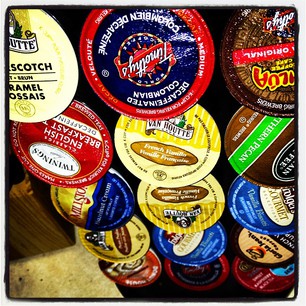Every Sunday— my “cheat day”—I enjoy a cup of flavored coffee. Drinking coffee in itself isn’t anything out of the ordinary, as I drink it daily. But the flavoring adds a twist, and it’s a decision not taken lightly. Like a pig being roasted, the K-Cup tower is slowly rotated. My eyes scan the packaging. [...]
 Every Sunday— my “cheat day”—I enjoy a cup of flavored coffee. Drinking coffee in itself isn’t anything out of the ordinary, as I drink it daily. But the flavoring adds a twist, and it’s a decision not taken lightly.
Every Sunday— my “cheat day”—I enjoy a cup of flavored coffee. Drinking coffee in itself isn’t anything out of the ordinary, as I drink it daily. But the flavoring adds a twist, and it’s a decision not taken lightly.
Like a pig being roasted, the K-Cup tower is slowly rotated. My eyes scan the packaging. I’m a sucker for good branding and design. Whatever catches my fancy is thrown in the Keurig, is brewed, and is mine to savor.
But there’s something that always prevents a fairy tale ending: 97% of the time, I hate the flavoring.
I like my coffee, or, even better, my Americano, just like my metal: black. (Mindless Self Indulgence, anyone? No? Fine.)
So if I’m continually disappointed by the failure of artificial flavoring’s ability to massage my taste buds, why do I return every week?
I have no idea.
Because it’s kind of fun? Kind of adventurous? (Great life I live, right? Getting a kick from drinking flavored coffee.)
And I can’t help but think this is how the majority of people construct training programs. They already have something solid—their black coffee—yet they’re compelled to extend their tentacles into different areas.
SOMETHING FOR EVERYONE, NOTHING FOR ALL
Unless my coffee adventuring gives me cancer (from the plastics or artificial flavoring), being dissatisfied every week isn’t a big deal. But when it comes to exercises and programs, getting caught up in mass selection leads to failure.
There’s something out there for everyone. But everything isn’t for everyone. Exercises, exercise methods, and programs are personal.
THE STRIP DISTRICT
Here in Pittsburgh there is a part of town called the Strip District. It’s a bunch of vendors, shops, and stores located on a centralized street.
About a year ago, I was on a quest for cheese. So I went to the Strip District, and went into this big Italian shop that sells over one-hundred varieties of cheese. One. Hundred. Different. Cheeses.
When my number was called, I was lost in a sea of choice. The monger asked me to name three cheeses I liked.
Mozzarella, provolone, and muenster.
Within thirty seconds I was out of the store, cheese in hand.
One cheese out of over one-hundred. (It was Alta Badia, by the way. And it was fantastic.)
It’s easy to see a big selection and want samples of everything.
“Ooh, hip thrusts.”
“Ooh, good mornings.”
“Ooh, incline flies.”
“Ooh, squeeze presses.”
Oohs and ahhs can last a long time. A lonnng time.
The reason why the selection is so vast is because everyone has different tastes. The backing behind the 242 Method and Program is to find what you enjoy most and narrow exercise selection into, at maximum, two lower body lifts and two upper body lifts.
FINDING YOURS
Finding your own Alta Badia is tough. It’s why the majority of people can’t write a program for themselves.
I couldn’t pick out a cheese myself. The monger did it for me based on what I liked. Without him, I would have been lost. But he delivered and that was it. I didn’t question him. I didn’t wonder about the other cheeses.
This all, of course, has relevance, and the 242 Method never “fully” hit me until I took a long look back at both my own training and my coaching client’s training.
THE ORIGIN OF THE 242 METHOD
A few months ago, I evaluated my training evolution across the six-and-change years that I’ve dabbled in this space. And, although embarrassing, I’m not afraid to spill the beans.
In 9th grade, a girl told me I had boobs. And that hits a self conscious kid hard. So over my training career, I obsessed over my chest because my lower pecs have always dominated my upper pecs.
At first, I listened to powerlifters and benched. My lower chest grew further out of proportion, leading me to more unhappiness. So I switched to a different angle press. Then after feeling weak, I hopped back to benching. And then benching did the same thing it did before, so I searched for another exercise. After that, another. Another. Another.
To this day, my pressing strength is awful—one of the reasons you never see me write much about pressing. (Outside of my dumbbell floor press article, which was my Alta Badia last year during softball and frisbee season as my shoulder was a wreck.)
In six years, I’ve gotten nowhere with my pressing exercises. Yet, from a muscular standpoint, I’ve surely gotten somewhere. So I looked back at the exercises I have progressed on, strength wise. To my surprise, there’s really only two: the deadlift and the chin-up.
Sure, when I first started I could only squat 95 pounds and have since squatted 405 (even though, both times, I hurt my back). But outside of the mileage put on my body with the sheer volume of exercise, the two primary drivers behind where I am today have been the chin-up and the deadlift.
The sad part is, lately, my deadlift is down because of the 20 Rep Squat Journey I went on. (For those that are unaware, it came to a halt because the nerve pain in my foot returned.) But the very fact that I went on the 20 Rep Squat Journey illustrates my dysfunctional in-search-of-cheese mind.
THE BIG QUESTION
If two exercises were the primary drivers of my own personal physical gains—from a strength standpoint—why are we worried about finding, testing, and using something that likely won’t work as well as what’s been shown to work for years?
So while I finish the second article in the series, I have some important questions for you:
1) What two exercises have been the primary drivers of your success?
2) What’s your favorite cheese?
3) What’s your favorite coffee?
4) What are your four money exercises?
Enjoy this article? See the next one in the series -> The Philosophy of the 242 Method.